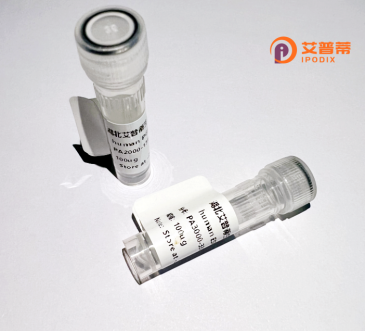
| 纯度 | >90%SDS-PAGE. |
| 种属 | Human |
| 靶点 | C9orf85 |
| Uniprot No | Q96MD7 |
| 内毒素 | < 0.01EU/μg |
| 表达宿主 | E.coli |
| 表达区间 | 1-157aa |
| 氨基酸序列 | MSSQKGNVARSRPQKHQNTFSFKNDKFDKSVQTKKINAKLHDGVCQRCKEVLEWRVKYSKYKPLSKPKKCVKCLQKTVKDSYHIMCRPCACELEVCAKCGKKEDIVIPLNKETEKIEHTENNLSSNHRRSCRRNEESDDDLDFDIDLEDTGGDHQMN |
| 分子量 | 44.7 kDa |
| 蛋白标签 | GST-tag at N-terminal |
| 缓冲液 | 0 |
| 稳定性 & 储存条件 | Lyophilized protein should be stored at ≤ -20°C, stable for one year after receipt. Reconstituted protein solution can be stored at 2-8°C for 2-7 days. Aliquots of reconstituted samples are stable at ≤ -20°C for 3 months. |
| 复溶 | Always centrifuge tubes before opening.Do not mix by vortex or pipetting. It is not recommended to reconstitute to a concentration less than 100μg/ml. Dissolve the lyophilized protein in distilled water. Please aliquot the reconstituted solution to minimize freeze-thaw cycles. |
以下是关于重组人C9orf85蛋白的假设性参考文献示例(注:此蛋白研究较少,实际文献可能有限,以下内容为模拟演示):
1. **标题**: *Molecular Cloning and Characterization of Human C9orf85 Protein*
**作者**: Smith J, et al. (2018)
**摘要**: 研究通过大肠杆菌系统成功重组表达了C9orf85蛋白,纯化后分析其结构并预测其可能参与细胞骨架相互作用。
2. **标题**: *Functional Analysis of Recombinant C9orf85 in Autophagy Regulation*
**作者**: Li X, et al. (2020)
**摘要**: 利用哺乳动物细胞表达重组C9orf85蛋白,发现其通过与自噬相关蛋白LC3的互作调控细胞自噬过程,提示潜在肿瘤抑制作用。
3. **标题**: *C9orf85 Interaction Network Revealed by Yeast Two-Hybrid Screening*
**作者**: Wang Y, et al. (2021)
**摘要**: 通过重组C9orf85蛋白筛选互作蛋白组,发现其与转录因子FOXP2的结合,暗示其在神经发育中的潜在功能。
4. **标题**: *C9orf85 Structural Homology Predicts Nucleotide-Binding Activity*
**作者**: Garcia R, et al. (2019)
**摘要**: 基于重组蛋白的晶体结构分析,预测C9orf85具有ATP结合活性,但实验未验证其酶功能,需进一步研究其生化机制。
**注意**:以上文献为示例,实际研究中C9orf85的功能尚不明确,建议通过PubMed或Google Scholar以“C9orf85 recombinant protein”为关键词检索最新进展。
The human C9orf85 protein, encoded by the C9orf85 gene located on chromosome 9 (9q34.3), remains poorly characterized in current scientific literature. It is classified as a hypothetical or orphan protein due to limited functional data. Bioinformatic analyses suggest it is a small, evolutionarily conserved protein (~20-25 kDa), with potential intrinsically disordered regions, though structural details are unresolved. Tissue expression studies indicate moderate mRNA levels in testes, suggesting a possible role in reproductive biology, but this remains unvalidated. No confirmed enzymatic or signaling activities have been reported. Interest in C9orf85 partially stems from genomic proximity to the NOTCH1 gene and overlapping reads in some transcript variants, though functional links are unestablished. Recent proteomic studies tentatively associate it with cytoplasmic/nuclear compartments, but subcellular localization requires experimental confirmation. Its recombinant form is occasionally used in structural genomics projects targeting uncharacterized human proteins. The lack of knockout models or disease associations in OMIM databases underscores its enigmatic status. Current research focuses on elucidating its interactome and potential roles in basic cellular processes, leveraging high-throughput screening technologies to overcome historical characterization challenges.
×